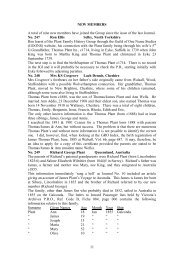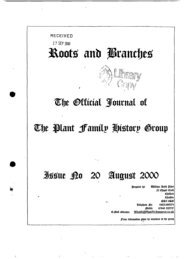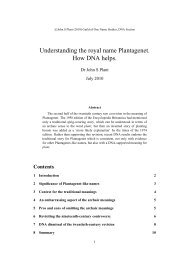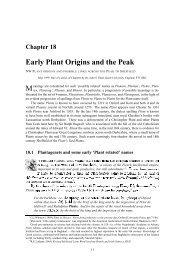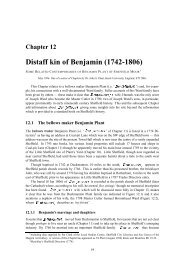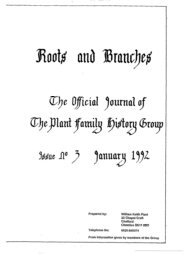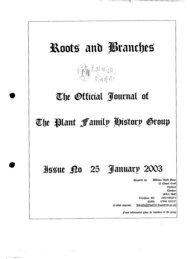Chapter 34 Austin Plant - Plant Family History Group
Chapter 34 Austin Plant - Plant Family History Group
Chapter 34 Austin Plant - Plant Family History Group
Create successful ePaper yourself
Turn your PDF publications into a flip-book with our unique Google optimized e-Paper software.
<strong>34</strong>.3. AUSTIN’S FINAL BATTLES 33<br />
subjected to shell-fire, machine gun fire and gas. The British cemetery at Hooge contains some<br />
2,000 graves.<br />
In Passchendaele: The Story behind the Tragic Victory of 1917 Philip Warner writes:-<br />
and:-<br />
There were battles around Hooge in 1915: the Château stood on slightly higher ground<br />
and the area was heavily garrisoned by German troops. The position was mined by the<br />
British troops and when it was blown up a huge crater was left. It became known as the<br />
Witches Cauldron, and as bodies fell or were flung into the water which soon filled it,<br />
the crater became indescribable.<br />
Here the enemy were very close, but even closer were the dead of both sides, under their<br />
feet, half buried in the sides of trenches, lying in the slimy water in the shell holes, and<br />
constantly disturbed by shelling and digging. Even for the dead there was no peaceful<br />
resting place.<br />
Black Watch Corner is a little over a mile to the east of Hooge, near Polygon Wood, and Beatrix<br />
Brice records an action (4 Oct 1917) that was almost contemporary with <strong>Austin</strong> <strong>Plant</strong>’s death:-<br />
By the time the attack was launched all indication of the route had been blasted away<br />
by the enemy’s shells and the way between two deep morasses was one of infinite peril.<br />
What was left of the road was in full view of the enemy, and the advancing tanks were<br />
met by a hurricane of shells, rifle and machine gun bullets.<br />
A little earlier, in the ‘morale boosting’ trench newspaper The B.E.F. Times, No 2, Vol 2 of<br />
Saturday 8 Sep 17, there had appeared a slightly more light-hearted account of the nearby Menin<br />
Road, through Hooge, under the heading Seen from an Aid-Post:-<br />
There are many roads on Flanders, where the horses slide and fall,<br />
There are roads of mud and pavé, that lead nowhere at all,<br />
They are roads that finish at our trench; the Germans hold the rest.<br />
But of all the roads in Flanders, there is one I know the best.<br />
It’s a great road, a straight road, a road that runs between<br />
Two rows of broken poplars, that were young and strong and green.<br />
You can trace it from old Poperinghe, through Vlamertinghe and Wipers;<br />
(It’s a focus for Hun whiz-bangs and a paradise for snipers)<br />
Pass the solid Ramparts, and the muddy moat you’re then in,<br />
The road I want to sing about — the road, that leads to Menin.<br />
It’s a great road, a straight road, a road that runs between<br />
Two rows of broken poplars, that were young and strong and green.<br />
It’s a road, that’s cursed by smokers; for you dare not show a light;<br />
It’s a road, that’s shunned by daytime; and is simply used by night,<br />
But at dark the silent troops come up, and limbers bring their loads<br />
Of ammunition to the guns, that guard the Salient’s roads.<br />
It’s a great road, a straight road, a road that runs between<br />
Two rows of broken poplars, that were young and strong and green.<br />
And for hours and days together, I have listened to the sound<br />
Of German shrapnel overhead, while I was underground<br />
In a damp and cheerless cellar, continually trying<br />
To dress the wounded warriors, while comforting the dying<br />
On that muddy road, that bloody road, that road that runs between<br />
Two rows of broken poplars, that were young and strong and green.



